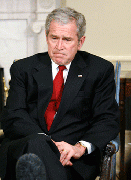WASHINGTON (IPS) — Until mid-2007, there was a serious political obstacle to a massive conventional war by Israel against Hamas in Gaza: the fact that Hamas had won free and fair elections for the Palestinian parliament and was still the leading faction in a fully legitimate government.

|
|
U.S. President George W. Bush looks down as he speaks from the Oval Office of the White House in Washington about the situation in Gaza January 5, 2009. REUTERS/Kevin Lamarque |
Hamas won 56 percent of the seats in the Palestinian parliament in the January 2006 elections, and the following month, the Palestinian Legislative Council voted for a new government under Hamas Prime Minister Ismail Haniyeh. The Bush administration immediately began to use its control over the “Quartet” (the U.S., European Union, United Nations and Russia), to try to reverse the results of the election.
The Quartet responded to the Hamas victory by demanding that Hamas renounce all armed resistance to Israel and even “disarm” before a political solution was reached. That was in effect a demand that Israel be allowed to use its military and economic controls over the West Bank and Gaza to impose its own unilateral solution on the Palestinians.
Meanwhile, the Bush administration and the Europeans cut off all financing for the Palestinian government, while Israel refused to hand over to the Palestinian authorities the VAT and customs duties it collected on behalf of the Palestinians under the Paris Protocol signed with the PLO as part of the Oslo Accords.
When Abbas continued to resist U.S. demands for an end to the elected government, both Secretary of State Condoleezza Rice and Israeli Foreign Minister Tzipi Livni told him at the United Nations in September 2006 that they would not accept a Palestinian government with Hamas participation.
Then Rice was dispatched to Ramallah in early October 2006 to tighten the screws on the Palestinian president. She demanded a commitment from Abbas to dissolve the Haniyeh government within two weeks, and then accepted his promise to do so within four weeks, according to a later U.S. State Department memorandum published in Vanity Fair magazine.
There was one problem, however, with the U.S. demand: under Article 45 of the Palestinian Authority’s “Basic Law,” Abbas could fire the prime minister, but he could not appoint a new one who did not represent the majority party in the Palestinian Legislative Council.
Abbas failed to act on the dissolution promise, so the Bush administration gave him a memo demanding that Hamas be given a “clear choice, with a clear deadline” to accept or reject “a new government that meets the Quartet principles.” The memo, published in part last January in Vanity Fair, said that if Hamas refused that demand, “you should make clear your intention to declare a state of emergency and form an emergency government explicitly committed to that platform.”
It further demanded that Abbas “strengthen his team” by bringing in “credible figures of strong standing in the international community.” That was a reference to the long-time director of Fatah’s paramilitary forces, Muhammad Dahlan, who had long been regarded as the candidate of the Bush administration and its allies. In April 2003, Yasser Arafat had been under pressure from British Prime Minister Tony Blair and Egyptian President Hosni Mubarak to name Dahlan as head of Palestinian security.
In late 2006, Rice got Egypt, Saudi Arabia and the United Arab Emirates to agree to provide covert military training and money to equip a major increase in Dahlan’s militia.
But there was another element of the Bush administration plan. It encouraged Dahlan to carry out attacks against the Hamas security and political infrastructure in Gaza, which were well-known to be far stronger than that of Abbas’s Fatah faction. In a later interview with Vanity Fair, Dahlan admitted that he had carried out “very clever warfare” against Hamas in Gaza for many months.
Other sources said that Dahlan’s militia was carrying out torture and kidnappings of Hamas security personnel.
Alvaro de Soto, then U.N. Special Coordinator for the Middle East Peace Process, wrote in his confidential End of Mission Report that the U.S. “clearly pushed for a confrontation between Fatah and Hamas…” He recalled that the “U.S. envoy” to a Feb. 2, 2007 meeting of the Quartet in Washington had twice declared, “how much I like this violence,” because “it means that other Palestinians are resisting Hamas.”
That U.S. envoy was Secretary of State Condoleezza Rice.
The Bush administration seemed to want Hamas to know about its plan to help Fatah use force against the Hamas organization in Gaza. A Jan. 5, 2007 Reuters story datelined Jerusalem revealed an internal U.S. document showing that the United States had pledged 86 million dollars to “strengthen and reform elements of the Palestinian security sector controlled by the PA presidency” and “dismantle the infrastructure of terrorism and establish law and order in the West Bank and Gaza.”
When Abbas negotiated a new agreement with Hamas in Mecca in February 2007 on a Palestinian unity government, the Bush administration responded by drafting a secret “action plan for the Palestinian presidency” which threatened that the “international community” would “no longer deal exclusively with the Presidency” if it did not go along with U.S. demands, and that “[m]any countries in the E.U. and the G8” would “start looking for more credible interlocutors on the Palestinian side who can deliver on key issues of security and governance.”
The plan, dated Mar. 2, 2007, called for Abbas to “start taking necessary action against groups undermining the ceasefire with the goal of ensuring all armed groups within Palestine security institutions in stages (between 2007 and 2008)…” It promised to help Abbas to “impose necessary order on the Palestinian street” through “superiority” of Fatah forces over Hamas, after which there would be new elections in autumn 2007.
Again that U.S. plan was not kept secret but was leaked in April 2007 by the Jordanian newspaper Al-Majd. That could only have happened if Jordanian intelligence services, which cooperative very closely with the United States, made the decision to leak it to the press.
Then, on Jun. 7, 2007 the Israeli daily newspaper Haaretz revealed that Israel had been asked to authorize the shipment of dozens of Egyptian armored cars and hundreds of rockets and thousands of hand grenades for the Fatah security forces.
The leaked plans for a military buildup were an open invitation to Hamas to take preemptive action. The day after the Haaretz story, Hamas launched a campaign which eliminated the Fatah security presence in Gaza in five days.
The day after the complete defeat of Dahlan’s forces in Gaza, Abbas dissolved the Haniyeh unity government and named his own prime minister, in violation of the Palestinian charter.
The rout of Dahlan’s forces was a predictable consequence of the Bush administration’s policy. As the commander of Fatah’s al-Aqsa Martyrs’ Brigades, Khalid Jaberi, told Vanity Fair’s David Rose, “We can only conclude that having Hamas in control serves [the Bush administration’s] overall strategy, because their policy was so crazy otherwise.”
But the Bush administration had not only accomplished its goal of eliminating a Hamas-dominated government; it had also set up a new argument that could later be used to justify an all-out Israeli offensive in Gaza: that Hamas had mounted an “illegal coup” in Gaza. That was the term that Rice used on Jan. 2 in justifying the Israeli operations against Gaza.
Gareth Porter is an investigative historian and journalist specializing in U.S. national security policy. The paperback edition of his latest book, “Perils of Dominance: Imbalance of Power and the Road to War in Vietnam”, was published in 2006.






Leave a Reply